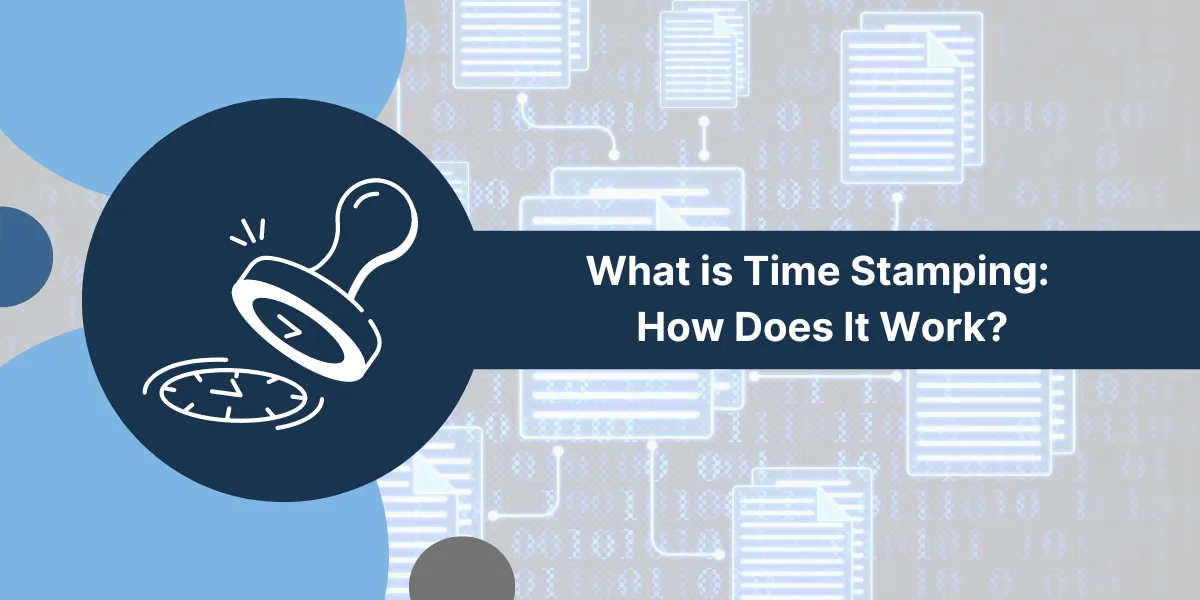What Does Time Stamping Mean?
Time stamping is the process of recording the date and time that a document, file, or data is created, modified, accessed, received, or sent. It provides a chronological reference point that establishes when information existed at a particular moment in time. Time stamps are commonly used for legal, regulatory, and business purposes to prove when certain events occurred.
They enable tracking the sequence of events and provide evidence in case proof of timing is needed. Time stamping can be done manually or automatically using computer systems.
Accurate time stamps depend on clock synchronization across the systems, which creates and records the timestamps. Overall, time stamps are crucial for establishing the timeline of information and transactions.
Key Takeaways
- Time stamping records the date and time a document, transaction, or event occurred.
- It provides verification and proof of when something happened.
- Time stamps are used for record-keeping, security, and establishing timelines and sequences.
- They can be applied automatically by software systems or manually by users.
- Cryptographic time stamps use digital signatures to prevent tampering with date and time data.
- Blockchains provide decentralized, distributed time stamping on transactions.
- Use cases include financial transactions, medical records, file versioning, copyrights, and more.
- Timestamp Authority (TSA) servers issue cryptographic time stamps.
- Accuracy of time stamping relies on clock synchronization using NTP.
What Problems Does Time Stamping Solve?
Time stamping solves several common problems:
Record Keeping
- It provides an official time and date associated with documents, transactions, communications, and other records. This allows precise tracking, sequencing, and chronological ordering.
Authentication
- The date and time act as proof of when something existed or occurred. This verifies authenticity and integrity.
Security
- Time stamps detect tampering or backdating of records. It reveals unauthorized changes by intruders.
Timelines
- Timestamps establish timelines of events and sequences of transactions. This reconstructs histories accurately.
Accountability
- They assign responsibility by showing who accessed systems and records at specific times. This provides accountability.
Compliance
- Regulations often require time stamping for legal compliance, such as time limits on documents.
How Does Time Stamping Work?
Time stamping works by recording the current date and time from a computer’s system clock at the moment an event occurs. This timestamp is associated with the relevant document, transaction, or data.
There are two main approaches:
- Automatic Time Stamping
- Manual Time Stamping
- Trusted Time Sources
Automatic Time Stamping
Many systems automatically time stamp data as it is generated. For example:
- File systems record time stamps when files are created, modified, or accessed.
- Databases time stamp transactions and records.
- Email systems time stamp outgoing and incoming messages.
- Network devices time stamp log events and packets.
- ERP/CRM systems time stamp customer records and activities.
The system clock provides the current time to timestamp events at the exact moment they occur.
Manual Time Stamping
Users can also manually time stamp documents by:
- Writing the date & time on paper documents.
- Typing time stamp comments in files and data records.
- Setting metadata fields in documents or databases.
- Affixing time stamp seals on physical documents.
This relies on users accurately recording the time from a trusted clock source.
Trusted Time Sources
Accurate time stamping relies on having a standardized authoritative time source, such as:
- Internet standard NTP time servers
- GPS satellite time signals
- Radio time signal broadcasts like WWVB
- Trusted local server stratum clocks synchronized to these sources.
Cryptographic Time Stamps
Standard time stamps can be altered by changing the system date & time. Cryptographic time stamps prevent tampering by using digital signatures:
Process
- A cryptographic hash is generated from the document or data being time-stamped.
- This hash is sent to a Time Stamp Authority (TSA) along with the current date & time.
- The TSA combines the hash and time data, then digitally signs it with the TSA’s private key.
- The digitally signed timestamp is returned and stored with the original document.
Verification
The timestamp can be verified later by:
- Decrypting the time stamp signature with the TSA’s public key to ensure it has stayed the same.
- The same hashing algorithm was used on the document, and the hash values were compared.
- Checking the time stamp date & time logs from the TSA.
Blockchain Time Stamps
Public blockchain networks like Bitcoin provide distributed trustless time stamping:
- Miners time-stamp transactions into immutable blocks.
- The distributed ledger includes proof of the time sequence across nodes.
- No central TSA is needed as trust comes from decentralized consensus.
- The blockchain acts as a permanent distributed record of time stamps.
Use Cases and Applications
Time stamping has many uses across different industries and processes, including:
Finance
- Time stamping financial transactions like payments, trades, and EFTs.
- Timestamping bookkeeping records and journal entries.
- Recording timestamps on legal contracts and documents.
Healthcare
- Electronic health records and patient data.
- Timestamping medical reports, scans, images, and videos.
- Recording timestamps on prescriptions.
Legal / Government
- Time stamping filed documents, registers, and deeds.
- Timestamps on evidence, case files, and exhibits.
- Records of arrests, convictions, and court proceedings.
Technology
- File timestamps in operating systems and repositories.
- Version histories in software development.
- Logging events, network data, and security footage.
- Timestamping code commits and builds.
Business
- Electronic invoices, purchase orders, receipts.
- Supply chain events and logistics records.
- Customer support interactions and service records.
Research
- Lab notes, data entries, and experiment logs.
- Records of observations and measurements.
Copyright
- Providing evidence of when creative works were authored.
- Prior art proofs for patents and intellectual property.
Time Stamp Accuracy
The accuracy of time stamps depends on:
- Clock synchronization: All time stamping systems must synchronize clocks to a common, accurate time source, typically using the Network Time Protocol (NTP) and a stratum of servers. This ensures consistency between time stamps from different systems and locations.
- Clock drift: System clocks can drift over time and require periodic re-synchronization. NTP algorithms compensate for normal drift.
- Time granularity: The precision of the time stamp: whether it has millisecond, microsecond, or nanosecond granularity. Higher precision provides more accurate sequence and timing.
- Time zones: Time stamps should record UTC time to avoid time zone conversion errors. Local timestamps should include the time zone.
- Leap seconds: Inserted seconds to account for irregularities in the earth’s rotation should be handled properly.
What are the Challenges with Time Stamping
Some challenges with time stamping include:
- Forged time stamps: Cryptographic time stamps prevent this but require a trustworthy TSA.
- Altering system time: Controls, like secured BIOS, NTP, and redundant sources, reduce this risk.
- Lack of standards: Proprietary time stamps can cause interoperability issues. Standard protocols like NTP provide consistency.
- Clock synchronization failures: Robust NTP deployment with backup stratum servers prevents this.
- Dependence on TSA availability: Distributed blockchain time stamping avoids a single point of failure.
- Colluding attackers: Sufficiently decentralized networks mitigate this risk.
- Timestamp verification complexity: Standards and libraries help application integration.
- Legacy systems without time stamping: Difficulty in backfitting into aging systems.
Time Stamping Standards
There are both national and international standards for time stamping practices and protocols, including:
- ANSI ASC X9.95: US standard for trusted time stamps, led by the American National Standards Institute.
- RFC 3161: IETF standard for cryptographic time-stamping using Time Stamp Authorities (TSAs).
- FIPS 140-3: US government standard for cryptographic modules like TSAs.
- IETF RFC 5905: Standard for Network Time Protocol (NTP) time synchronization.
- ISO/IEC 18014: International standard for trusted time-stamping services.
- ETSI TS 101 861: European Telecommunications Standards Institute (ETSI) standard for time stamping.
- ISO 8601: International standard for representing date and time formats.
Time Stamp Authority (TSA)
A Time Stamp Authority (TSA) provides trusted cryptographic time-stamping services.
- Operate as dedicated time stamp servers accessible over a network.
- Have a public/private key pair for digitally signing time stamps.
- Log all time stamps issued with related request details.
- Synchronize with highly accurate time sources like GPS and NIST.
- Achieve high availability through redundancy.
- Meet security standards and auditing requirements.
Well-known TSA providers include:
- IdenTrust: Provides TSA services for businesses and government, as well as compliance.
- DigiCert: Issues trusted time stamps integrated with certificate offerings.
- GlobalSign: Major SSL/TLS certificate authority providing time stamps.
- Sectigo: Leading certificate authority with cloud-based TSA service.
- Amazon Time Sync Service: Fully-managed AWS time-stamping service.
- Microsoft Authenticode Timestamping: Integrated Windows code signing time stamps.
Time Stamping in Blockchains
Public blockchains like Bitcoin and Ethereum provide decentralized time stamping of transactions:
- Miners timestamp transactions as part of the immutable blocks added to the chain.
- The distributed ledger provides verifiable proof of time sequencing.
- Consensus ensures timestamps cannot be altered without detection.
- All nodes have synchronized clocks following blockchain time.
- No central TSA is required as trust comes from the decentralized network.
Interplanetary Time Stamping
Interplanetary time stamping provides trusted timestamps for proving the prior existence of documents and data across different planets:
- It is required to establish legal precedence, intellectual property, and rights across interplanetary commerce and communications.
- It must account for relativistic effects between locations, like time dilation.
- Could utilize trusted timestamping incorporated into interplanetary distributed ledgers and blockchains.
- Cryptographic proofs are verifiable across planets.
- Reliable interplanetary networks become critical infrastructure.
The Future of Time Stamping
Time stamping technology will continue evolving:
- Blockchains could displace centralized TSA servers.
- Integration with zero-knowledge proofs and trusted execution environments.
- Richer metadata in time stamps using schemas like JWT.
- Layer 2 protocols for energy-efficient high-volume time stamping.
- Use of trusted hardware like TPM chips for resilience.
- Fully decentralized trustless time stamping between strangers.
- Interplanetary time stamps spanning galaxies using quantum cryptography.
Final Words
Time stamping is a critical technology that provides verified proof of the recording date and time for documents, transactions, and events. Whether applied automatically or manually, time stamps establish timelines, sequences, and legal evidence.
Cryptographic time stamps utilize digital signatures to prevent tampering by linking data to trusted Time Stamp Authorities. Blockchains are emerging as decentralized alternatives. As our world becomes increasingly digital, assured records of time will remain essential across many use cases and industries.
Time stamping delivers trust in the integrity and authenticity of digital data through time. The continued evolution of cryptographic guarantees, decentralization, and standardization will ensure time stamps stay essential infrastructure.
Frequently Asked Questions About Time Stamping
What is a time stamp?
A timestamp is metadata that records the date and time that a document, transaction, or event occurred. It provides proof of when something existed or happened.
Why is time stamping important?
Time stamps provide verification of timing that is crucial for record keeping, establishing sequences, detecting backdating fraud, meeting compliance rules, and more.
How does time stamping work?
Time stamping records the current date/time from a computer’s clock at the moment a file is created, or an event happens. This timestamp is associated with the data.
What is a cryptographic time stamp?
It uses digital signatures to prevent tampering with the date and time data associated with documents. This proves that the data existed at that time.
What is a Time Stamp Authority (TSA)?
A TSA issues cryptographic trusted time stamps by digitally signing document hashes and timestamps with the TSA’s private key.
How are time stamps used in blockchains?
Blockchains like Bitcoin timestamp all transactions by ordering them in timestamped blocks that act as a permanent ledger of record.
How accurate are timestamps?
Accuracy depends on standardized time sources, clock synchronization, timestamp precision granularity, and consistent time zones.
What standards exist for time stamping?
Standards like ANSI X9.95, RFC 3161, and ETSI 101 861 establish protocols and security requirements for trusted time-stamping.
How reliable are time stamps as legal evidence?
Cryptographic time stamps from a reputable TSA provide strong legal evidence of document existence at a certain point in time.
Can time stamps be forged?
Ordinary time stamps can be forged by altering system clocks. Cryptographic time stamps prevent this using digital signatures tied to TSAs.
Are time stamps required for legal documents?
It depends on the jurisdiction and type of document. Time stamps help meet rules regarding statutes of limitations and protocol sequences.

Priya Mervana
 Verified Web Security Experts
Verified Web Security Experts
Priya Mervana is working at SSLInsights.com as a web security expert with over 10 years of experience writing about encryption, SSL certificates, and online privacy. She aims to make complex security topics easily understandable for everyday internet users.



